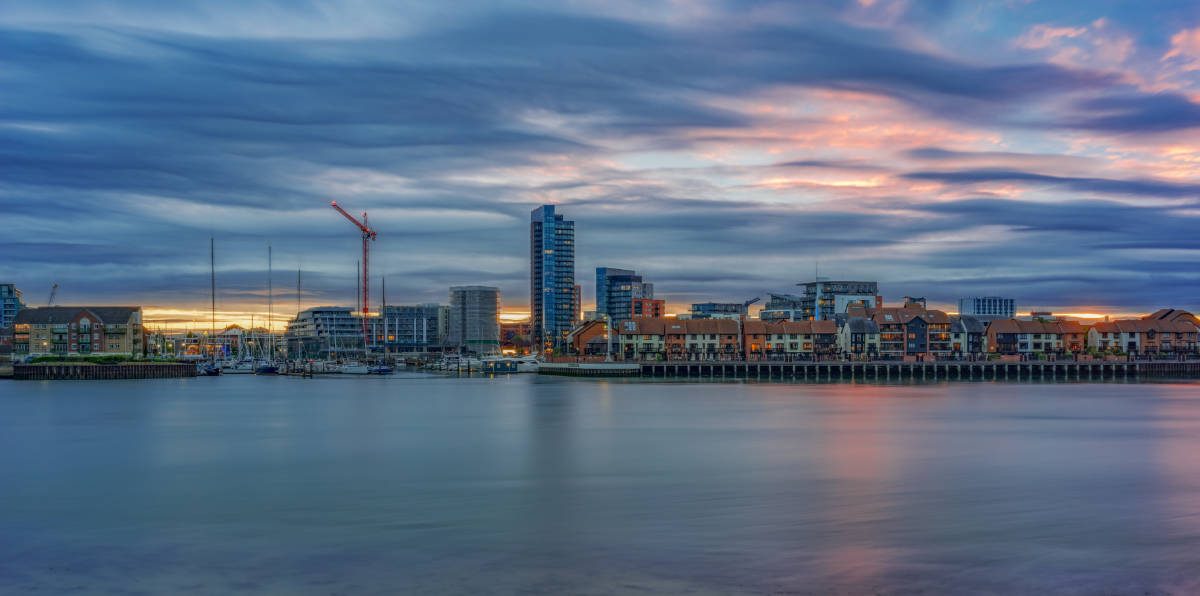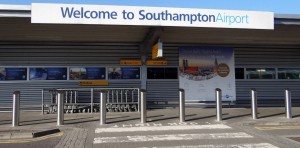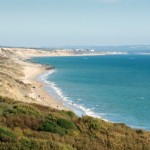
Southampton – in Five Minutes Flat!
The Real River City
Somewhere South of London, but north of Portsmouth, you will run across Southampton. The city that really ought to have an extra ‘H’ in the spelling. It is made up mainly of rivers, with the New Forest to the north.
An aside to say the New Forest is amazing. Did you know they let the animals roam free? There are wild-but-owned cows and horses, goats, sheep – the whole works – all wondering around down there between the trees. Drive carefully.
But back to the rivers. You have the Southampton Water, the River Trest, the River Itchen, and the River Hamble, all within walking distance of the city. As well as being the staff meeting place of all rivers in the south of England, it also happens to be the home of its very own University, as well as BBC South. Southampton has an awful lot going for it…
…But you know us. We here at Five Minutes Spare want to know about the history, the attractions, and all the best bits of the city of Southampton. So let’s get to it, starting with how the city became a city in the first place…
Southampton – the birth of a town.
Since there are all sorts of rivers running around, though, under and above Southampton, it was always going to be an important location. Although it is believed to have been occupied since the stone age, this particular river city was first marked out definitely by the Romans. They wanted somewhere easily defensible that marked crossing places, as well as making a market for passing trade. They were about 800 years pre-Viking back then, so they didn’t yet know the danger of building things on a river… You can sort of see what’s coming, can’t you!
Anyway, the Roman fort was known as Clausentum and stayed inhabited until 410. When the Romans left Britain the little town was left completely abandoned. Since then, archaeological excavations have uncovered a grid-shaped street layout and even painted murals. Nearly two hundred years later the Saxon king of the time built his own version of the settlement, but this time built it across the Itchen.
This little town soon grew to become an important Anglo-Saxon settlement, with an estimated 5,000 inhabitants. In those days, that would be the equivalent of modern-day London in terms of population. It was massive. The people made a roaring trade in wool, but all of the elements of life would be found here. They called the town ‘Hampton’, which is where the county of Hampshire takes its name.
And then along came the Vikings.
Viking Hampton
So you have this huge city with all the wealth of Wessex in it, situated on the banks of four rivers. Then you add in an enemy that designed boats specifically so they could attack up rivers, and you start to get the idea. Back in those days, England wasn’t a place yet, so the western kingdom of Wessex had to fight this battle alone. Worse, they were fighting Vikings in Wales, from Northumberland and the north, and from the east, where Ivar the Boneless was either destroying or ruling.
Hampton had no chance. They probably didn’t even have any soldiers left to send there. On the plus side, they had plenty of river water to help them put the fires out.
The Vikings attacked relentlessly. Led by Olaf and Sweyn they camped on the eastern bank of the Itchen. The area is still sometimes referred to as Olaf’s Town but later became Woolston. The Anglo-Saxons paid them to leave and they did. This was a common Viking tactic. They simply set up shop outside towns to scare away any passing trade. The threat was enough. Often, they left with wealth and never lost a single warrior. As it was with Hampton.
Anyway, they came back. Paying them off never worked. They raided and burned, then raided some more. The best account we could find was here, courtesy of See Southampton.
The Viking King Canute was crowned in South Hampton. He went on to defeat the Anglo-Saxon Ethelred the Unready. He was crowned King of all England by the Witan, who was the sort of MPs of their time. The name Canute persists around town to this day, even although the Itchen silted up and the Vikings withdrew.
The successive raids combined with the silting of the main river left Hampton almost uninhabited. Most fled to Winchester for safety – but some didn’t. Some crossed the river once again, and this time to the south. They named the town Hampton, and over time it became South Hampton, and eventually dropped the space and the ‘H’. This is the city you know and love today.
The *Real* Southampton
When the Domesday Book was written just after the turn of the 10th century when it recorded Southampton as being a large town of 1,000 residents. This was still quite a lot of people, although nowhere near the previous glory days.
The Normans were next to invade. The town’s position so far south made it easy pickings, especially when the Normans could effectively sail up the river just as the Vikings had. They arrived in 1066 and were the first to build Southampton Castle, in wood. It was built in stone later after the French had gone. They separated the town into French-owned and English owned, then started trading wine for wool and cloth. Basically, it is the Norman’s fault we have alcoholism nowadays. And we should probably blame the Romans, while we are at it.
A friary went up in the 13th century, who then built a water system throughout the town. They didn’t let the public use it until 1310 but it’s the thought that counts. Notably, the town was once again attacked by the French in 1338. It’s just a locational thing. There was nothing to be done about it. They were also attacked by English rebels, wrote to the King to petition for £8,000 worth of damages, theft, and broken goods, and shortly received a handful of prison sentences as the King took offence. Some of the townsfolk ended up at Portchester Castle in the dungeons. That’s what happens when peasants complain. In a few hundred years – not much has changed.
In 1338 they built new town walls. A good move, about a thousand years too late. It did serve to keep up further attacks. They also added the first deliberately placed gun battery in England. This was mounted on their walls and worked hard to keep enemies out for good.
Plague hits Southampton
In 1348 the plague came through ports and into England. Some sources argue Dorset, some argue the west coast, some argue the ships docked in the important port of Southampton. The plague ravaged the whole of England. We do not have any accurate records of just how many were killed, but we do know that neighbouring estates had as much as a 100% fatality rate.
The plague returned in 1665 and hung around for a full year. It is reported that some 1,200 people died – which would have been about a fifth of the population back then. It is rumoured to have come from London. You can read all about this second outbreak in the Daily Echo.
From the 15th Century On…
Southampton was the home of a ‘plot’ after King Henry went off to fight at Agincourt. 4 lesser nobles were executed in the city, right about where the Bargate is nowadays. Henry VIII had a notorious love of friaries so that got disbanded during his reign. The Mayflower departed from Southampton’s port to take settlers to the Americas, and the town successfully thwarted the attempts of Royalists to take it in the 16th century… The first enemies to ever be turned back by the city.
In the end of the 15th century, the town turned its hand to shipbuilding. A number of king’s ships were built in their growing port. It became a medieval market town with an annual fair that rand for three full days. Since this fair took place near the Chapel it was called the Chapel fair. Spices, perfumes, clothes and wine were all trade items that were dealt near and far. They also provided sustenance for the long voyage of English troops over to America and helped feed the masses during the hundred years war.
Around 1531 Southampton stopped being the only port that exported lead and tin from the UK. Catastrophically, they also lost their trade with Italy – which was where the most money came from. They managed to pick up trade in wine once the hundred years war had finished, then make up extra trade from the Channel Islands… but the success of their ports would take another few hundred years to recover completely.
By the 16th century the port was nothing more than a ruin, although still in use. The Southampton Corporation tried to save it by decreeing that a certain type of French wine could only be procured through Southampton. Nevertheless, records from the end of the century have it as a decaying town with trees growing out of the walls. The town fell to poverty… the fine trader’s homes decayed and fell in. By the turn of the century, a bunch of craftsmen fleeing Belgium had settled in the town and become the main producers of Serge Cloth.
A grammar school opened in 1554, and the King sold the castle in 1618. Years passed. The town decayed, and the next entry in the history books comes in 1750.
Prince Frederick’s Revival
Prince Frederick visited the town to bathe in the seawater. At the time, it was believed that seawater could heal a myriad of diseases. He visited for two years in a row and died in the third year… so the obvious joke is that it didn’t work on him. Luckily for the town though, it worked for them. Royal followers visited in their masses and breathed money into the dilapidated town. Southampton became a place of notoriety for its saltwater. In 1801 the town had a reported 8,000 residents.
Towards the end of the 18th century, streetlights were erected in the form of gas lamps. Bridges were built and commissioners were erected to keep the peace. Incidentally, some of the first parking fines in the UK were handed out in Southampton. These commissioners would tie any carts blocking the street to an elected tree, and the owners would need to pay a fine to get them back again!
By the 19th century the port was thriving again. It was doing a roaring trade out of the Baltic ports, something that other towns had already been doing for quite some time. It seems that Southampton’s position on the south coast didn’t do it as well as it could have.
By 1820 folk stopped coming to bathe in the salty waters, leaving a deficit. During just about every war since then the soldiers have been shipped from Southampton, however. This meant they had a steady trade as the armies spent the last of their money – or the first of their paycheck, as the case may be. Many a King’s shilling was spent in this port town. In 1830 a steamship port was built. A steamer boat travelled between here and the mainland of Europe. It is estimated that it carried some 100,000 customers per year.
A cholera epidemic in 1849 meant new toilets were built, a sewer system was expanded, and lighting and water improvements continued. All of this failed to stop 240 people dying from the outbreak though. Later, in 1865, Cholera would take a further 151 lives at Southampton.
The World Wars
In 1914 more than 2000 men hailing from Southampton died fighting. Further, 8 million men passed through the city on their way to the front. WW2 saw similar numbers -with an added twist of fate. 631 people died in the city thanks to the successive blitzes. About 11,000 houses were irreparably damaged, leading to a severe housing shortage. Around 1946 the government threw up the Pre-fabs made from corrugated iron to house them. Much like the rest of the country, the poorest of people still lived in the pre-fabs in Weston Park right up until the sixties. There are people alive today who can still remember being brought up in a prefab… and that’s a little scary.
All sorts of new buildings were erected after the fateful Blitz years. Schools and hospitals were added, parks and recreational areas completed the picture. To this day, shipbuilding is a significant industry in Southampton. They also do very well from tourism. If you would like a more in-depth read into recent years Local Histories have an excellent account.
In the meantime let’s get stuck into the attractions!
Southampton Attractions
So if you had to spend time here and wanted to do the “touristy stuff”; what would you get up to? Don’t worry, we have all the important stops for your itinerary, right here.
Shopping
The best shopping in town can be held at the Westquay. This is a large retail shopping centre named for the fact that most of this city of rivers is a quay. If you want to spend the money your parents gave you for Christmas, this is where you come to do so. They also have several places to eat so you don’t need to worry about going hungry.
Historic Sights and Landmarks in Southampton
If you are looking for a free sight to see, then go peruse the university. Blend in with the students and you won’t be troubled. The University ranks 3rd in the UK for the high quality of their research and generally makes great contributions, all round. You could literally walk into the halls and take a lecture… nobody checks these things.
There is also an estate in Southampton you might like to check out. It is called Bitterne Manor. It is built on the sight of the old Roman fort and parts of it can still be seen. It’s not a manor house, don’t be misled, it’s just a park nowadays. They don’t neglect the religious here, either. St. Michael’s Church is a beautiful old building, which is still in use for services to this day… after being built in 1070…
The ports hold some fascinating stuff too. Check out the Steamship Shieldhall down at berth 110 in the docks. It is the largest working steam ship in Britain and isn’t likely to be there for much longer. If the Millennials and Gen Z get their way and the environment wins…
Galleries and Museums
The Burlesdon Brickworks Industrial Museum has a very keen take on the industrial revolution and how it affected the city. The SeaCity Museum is also a sight to see, since it deals with all things coastal. For a third option see the Tudor House and Garden that has been perfectly preserved. You can find the John Hansard Gallery inside the University – which gives you another reason to visit – but the Southampton City Art Gallery is where it’s really at.
Sports, Recreation, and Nature
The local soccer team are called Southampton, originally, and you can visit them or take a tour of their stadium. St. Mary’s Stadium holds more than 30,000 people – so this is one team with high expectations. The team are commonly called ‘the Saints’ for short.
There are plenty of things to do with the kids in Southampton. Take them to St. James’s Park for a walk or a picnic, head west of the city for ‘Into the Woods’ who are desperately seeking volunteers to protect their forest… a great way to keep fit, no?
Alternatively, take the kids to the Showcase or Odeon cinemas, the Flip Out Trampoline Park, or visit the aeroplanes at the Solent Sky Museum.
Where to Eat, Drink, Party and Stay in Southampton
When it comes to eating out, Southampton has you covered. Try the best Indian food at Kohinoor of Kerala, dine in style at Quay Fifteen, or enjoy a Greek family feast at Sulas. There is an option for every cuisine style in this popular tourist destination.
If eating out isn’t your thing but you still want to party – try the Cask Away Tasting Rooms for an afternoon (and evening) out. The Wellington Arms is the best place for a stiff pint and the Guide Dog also gets a great reputation.
If you are looking for great cocktails, try the Maritimo Lounge. The Ocean Village on Banana Wharf is also popular.
How to Get to Southampton

Image: Adam Loader/Shutterstock.com
So now we have covered everything except how you get there… guess what we did next?
By Road
If you head out of London in a general Easterly direction you will eventually find roads that lead to Southampton. That’s south and east, to be more specific. You are aiming for the M27. Once you find it stay on it and it will run you right around the southern coast if you want. From London, follow the M3.
By Rail
Again, from London, you should be able to find any number of trains running to Southampton. If you can’t be bothered to read the rail display boards then head southeast for about an hour and nine minutes. You will either hit Southampton or end up in the sea. To be honest, if you can’t look upwards at a train station then the sea is where you belong.
By Air
Southampton International Airport is currently up and open for business. We are not going to explain how you catch a flight and assume that you already know that.
By Sea
Unlike many of our local guides, you can actually reach Southampton by sea… the Vikings managed it so why not us? You are looking for Southampton Port and it should take you almost to the centre of town if you get dropped off there. Good luck!
Got Five More Minutes?
If you find yourself with time on your hands, we would love for you to check out our other articles. From literary masterpieces to the shocking and hilarious – you will find it all here at Five Minutes Spare.





